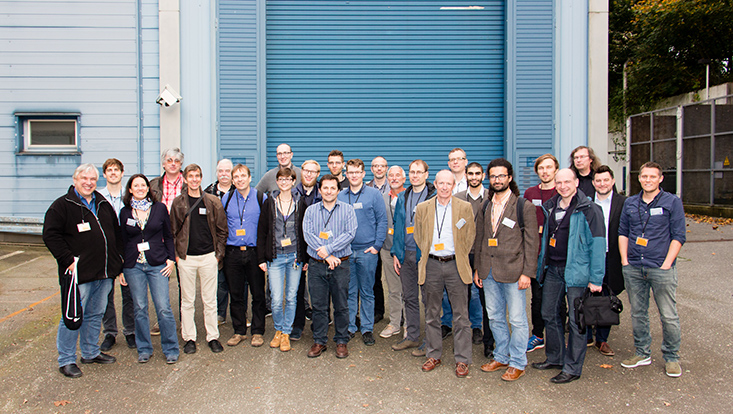and Natural Sciences
MADMAX: a new Experiment to investigate the nature of Dark Matter
20 October 2017, by MIN-Dekanat

Photo: UHH/MIN/Michael Grefe
The nature of dark matter is probably one of the most pressing questions in modern physics. Although the existence of Dark Matter, due to many astrophysical and cosmological observations of its gravitational influence, is difficult to refute, an experimental detection in the laboratory is still missing. Now it is planned to detect axions as candidates for dark matter with a totally new experimental approach. For this reason the MADMAX (MAgnetized Disc and Mirror Axion eXperiment) collaboration has now been founded.
Recent years have seen a rapid development in the improvement of sensitivity of experiments looking for interactions of dark matter with normal matter. Also the sensitivity of the CERN experiments on such particles has greatly improved in recent years.
Only the experimental discovery of such a particle candidate has so far failed. This leads more and more to the resurgence of an established hypothesis that was introduced independently of the dark matter problem in order to solve another fundamental problem of particle physics: the question of the unexplained symmetry between matter and anti-matter in the strong interaction. This hypothesis predicts the existence of so called axions that could also solve the Dark Matter problem.
The predicted particle, the so-called axion, could soon become more popular than other dark matter candidates. There are now several experiments and initiatives that search for axions as dark matter candidates. None of these experiments, however, is sensitive to axions in the mass range between 40 μV and 400 μV. This mass range is predicted in models in which axions were produced after the universe had expanded inflationarily.
In 2013, an idea was published that could actually make it possible to become sensitive enough in this theoretically very well-motivated mass range to actually detect dark matter axions. For this purpose, up to 80 discs from a material with a high refractive index with a diameter of ~1 m are to be placed into a magnetic field of ~10 T field strength. With the correct adjustment of the disc spacings this could result in resonant conversion of axions into microwaves (photons). These could then be detected with extremely sensitive microwave detectors.
Scientists from several research institutes have joined together to facilitate such an experiment:
On 18 October 2017, the MADMAX Collaboration has officially been formed.
Apart from the group at the Max Planck Institute for Physics, at which the basic concept has been developed, the MADMAX collaboration consists if research groups of the universities of Aachen, Hamburg and Tübingen, the University of Zaragoza in Spain, the French Research Institute for Fundamental Laws of the Universe CEA-IRFU in Saclay and the German Electron Synchrotron (DESY) in Hamburg.
The researchers of the newly founded MADMAX collaboration are planning a finding phase:
First it must be verified that the concept is at all feasible: the theoretical-phenomenological considerations that led to the concept have to be critically questioned.
Parallel to this first design studies on the feasibility of a suitable magnet and the necessary mechanics are carried out.
If no insurmountable obstacles are found, a smaller prototype will be built by 2021. Even with this, a sensitivity could be reached, which would allow to search for previously untestable "exotic dark matter particles".
With the final stage of the MADMAX experiment it should then be possible to cover an important parameter range for axions, which is predicted if axions are the dark matter. MADMAX is currently being planned at DESY in Hamburg.
Contact:
Dr. Michael Grefe
Phone: +49 (0)40 8998-2151
E-Mail: michael.grefe"AT"uni-hamburg.de
